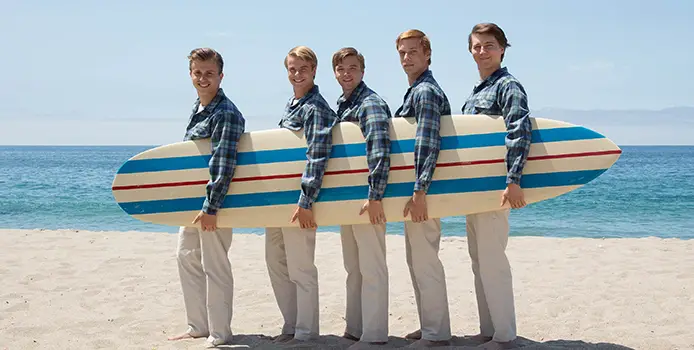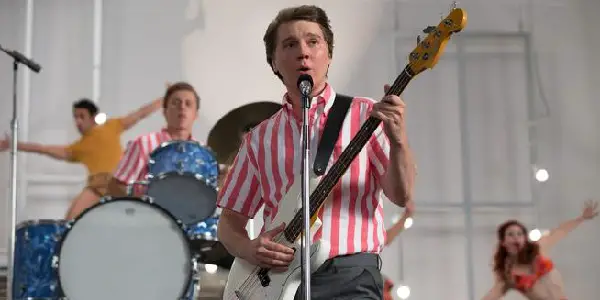LOVE & MERCY: Eccentric and Irresistible

Alistair is a 25 year old writer based in Cambridge.…
Ever since the glory days of silent cinema, Hollywood has been criticised of running out of ideas. This is why the biopic is the perfect genre for screenwriters and directors. A typical life doesn’t neatly fit into a simple three-act structure, but by highlighting an individual’s greatest successes, and framing them in a way that makes everything else inconsequential by comparison, you can turn something as uninteresting as somebody’s life into a thrilling drama. The downside to this is that in recent years, filmmakers are falling back on them more than ever before, to the point that it now seems as if half of the public figures on Wikipedia have their own Oscar-baiting biopic. I cannot be blamed for feeling “biopic fatigue”, yet there is one kind of biopic I am yet to tire of – the musician biopic.
More than just a “Greatest Hits”- style portrait of a musician
The stereotypical musician biopic frames its narrative like the best greatest hits album you’ve ever heard, rewriting their life story so every one of their songs feels like it was written specifically to tie in with the drama that is unfolding. The new Brian Wilson biopic Love & Mercy is the best big-screen dramatisation of a musician’s life since Walk the Line, due to how it ignores the conventional biopic structure and creates something instantly classic, yet also with an undercurrent of sadness – just like the music that Wilson created for the Beach Boys’s masterpiece album Pet Sounds.
Here, we never get to hear a finished song in its entirety, instead hearing different demos that highlight different sections of the dense instrumentations Wilson created for both Pet Sounds and their biggest hit, “Good Vibrations”. Rather than creating a simple pop music film, director Bill Pohlad has helped show the casual viewer why a band with such seemingly simple songs were so unique, in a manner that is as unconventional beneath the surface as anything Wilson wrote in his 60’s heyday.

Of course, using the term “biopic” seems reductive here. Pohlad has repeatedly stated that he had no intention of creating a biopic and just wanted to focus on two key elements of Wilson’s life. The earlier segment is the mid sixties, with Wilson (played in a characteristically unhinged performance by Paul Dano) trying to realise his vision for Pet Sounds, whilst fighting with his bandmates and estranged father, still bitter at discarding him as their manager. In the eighties, a washed-up Wilson is played by John Cusack in his best role since High Fidelity – something of an achievement considering he looks nothing like either Brian Wilson or Paul Dano. The two halves play out in tandem; although related solely by a central character, they help create a satisfying whole. The first half is the more interesting as it focuses on Wilson in the studio, slowly losing his mind as he tries to break new musical ground, all the while being haunted by the voices in his head.
This is where the structure would be rendered conventional under lesser direction. This is avoided here by the fact that we never hear a finished song and are instead fixating on Wilson’s struggle to achieve perfection, having difficulty translating the sounds in his head into songs, even when session musicians tell him he’s the greatest, most innovative musician they’ve ever worked with. It never follows the “greatest hits album” structure – instead we get one of the more authentic portraits of musicians in the studio-making music, with all the songs stripped to their bare bones, allowing us to marvel at how much instrumentation Wilson managed to fit into one song as we see his eccentric creative process.

One of the few weak points about Love & Mercy is that the Cusack section works to the detriment of this half in regards to musical performances. Whereas we see session musicians performing the songs live in the sixties, as well as live vocal takes, the sole musical performance in the late-period half contains Cusack obviously miming on a piano, showing us footage of fingers tapping the keys, but never in the same shot as the rest of his body.
Still thrilling when it flirts with biopic conventions
However, the Cusack section still makes for equally compelling drama when divorced from the rest of the film, even if the more conventional structure will likely render it the lesser of the two sections by audiences. Falsely placed under severe medication from controlling, borderline sociopathic Dr. Eugene Landy (played in a wonderfully sleazy turn from Paul Giamatti), this section sees Wilson cope with all the demons in his life as he attempts to start a relationship with car saleswoman Melinda Ledbetter (Elizabeth Banks), who proves to be the only positive influence in his life, one who keeps getting shut out due to Landy’s obsessive control.
This half of the film is more obviously driven by the high-calibre performances, which allows for less of the surrealism that helps make the earlier half an eccentric treat. It still has an offbeat charm, but due to exploring a more troublesome period in Wilson’s life, it has to be reigned in so the real-life horrors can be played with a straight face. This is the more emotionally overwhelming half; although the cast do overact at times, they always downplay at the right moments – Cusack’s Wilson talking about being beaten by his father as a dinner party anecdote is a scene where overacting wouldn’t do justice to the undercurrent of restrained emotions.

The “greatest hits” structure of music movies means that entire scenes play out as nothing more than set pieces, that work well individually but detract from the film as a whole. Although the movie contains a plethora of memorable scenes, even the showiest of the bunch help draw a deeper understanding of the characters. A scene where young Brian is tormented by the sounds of dinner table cutlery (yes, really) plays out like borderline-David Lynch style surrealism, but it helps illustrate that Wilson was tormented by far more than the “voices in his head”.
This scene alone should merit the film award nominations for sound editing and mixing. The fact that I was the only person in the cinema made it seem far louder, every bit as haunting to the audience as it is to Brian. All biopics share the belief that their protagonist is a genius, but Love & Mercy is miraculous in that it lets us occupy the same head space as a genius. Instead of admiring from afar, we hear his music in the same way he hears it, and are tormented by the same things that torment him.
Conclusion
Love & Mercy isn’t a groundbreaking movie, but it doesn’t need to be. It cares deeply about its subject and knows that it would be against Brian Wilson’s artistic spirit to treat his life in a conventional manner. Like The Beach Boys at their creative peak, Love & Mercy doesn’t conform to the mainstream, creating something challenging yet so irresistible that the mainstream has no choice but to climb on board.
What are your favourite musician biopics, and which biopics fail to do any justice to the artists they portray?
Love & Mercy is out now in the UK and US. All international release dates can be found here.
(top image source: Roadside Attractions)
Does content like this matter to you?
Become a Member and support film journalism. Unlock access to all of Film Inquiry`s great articles. Join a community of like-minded readers who are passionate about cinema - get access to our private members Network, give back to independent filmmakers, and more.
Alistair is a 25 year old writer based in Cambridge. He has been writing about film since the start of 2014, and in addition to Film Inquiry, regularly contributes to Gay Essential and The Digital Fix, with additional bylines in Film Stories, the BFI and Vague Visages. Because of his work for Film Inquiry, he is a recognised member of GALECA, the Gay & Lesbian Entertainment Critics' Association.













